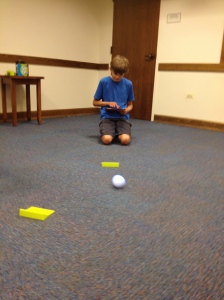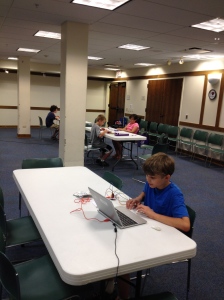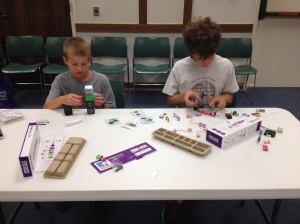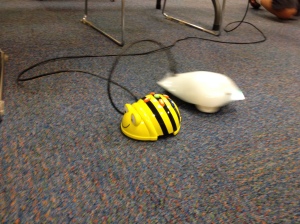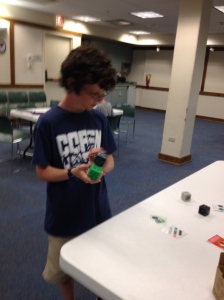Robot Basics:
- What is it?
Cubelets are a modular robotics teaching tool and toy from the aptly named Modular Robotics. Color coded, cube shaped pieces attach to one another with magnets, enabling the user to quickly and easily build a variety of robots.
- What’s in the Box?
The KT06 kit contains 2 rechargeable batteries, several “recipe” cards, a battery charging setup, and the following 6 cubes:
2 action cubes: drive and light
2 sensing cubes: brightness and distance
2 thinking cubes: power and passive
- How Much?
This kit retails for $159.95
- Age Range?
Cubelets are recommended for ages 4 and up. I had success engaging kids as young as four and as old as 8th grade, though the length of engagement varies.
- How Did We Acquire it?
We purchased it at full price with funds from our ILEAD USA grant. (Per their website, Modular Robotics does not offer discounts to educators or other groups.)
Ideas for Use
This set of Cubelets is a great tool for teaching the basic concepts of robotics to individuals or small groups. Specifically, this tool helps explain that a robot is a device that senses something and then responds to it in a pre-programmed way. It also demonstrates the specificity required in robotics: placement and orientation of the cubes matters, and the creation will act differently based on the arrangement of the pieces.
Time Involved
Charge up the batteries for a few hours and you’re good to go. There’s no additional prep time needed.
One-time or Recurring Program
While younger kids could have fun with Cubelets a number of times, the kit we purchased is limited in scope, so I wouldn’t count on engaging the same group with the same six cubes more that a few times. There’s little opportunity to build on the concepts presented without investing in more cubes.
That said, the cubes are extremely durable and nicely sized for small hands. In this way, they could be a standard introductory activity for any program that aims to build on these concepts. Also, they are just plain fun! Because they go together so quickly with such obvious visual results, they engage users young and old from the get-go. I took them to entice folks to visit the library’s table at the middle school registration night, and I had everyone from preschool aged siblings to “been there, done that” incoming 8th graders, to curious parents stopping by to make a Fraidy-Bot that runs away from you, or the inverse: a robot that follows your hand. There is a really appealing immediate gratification factor with Cubelets.
Extension Activities
This is a great tool to use as part of the explanatory process of a more complex robotics unit. There is a lot of potential for extension with the Cubelets themselves, but there are costs associated with them.
For an additional $14.95 we could purchase a brick adaptor, which would allow the Cubelets to be used with LEGO. For an additional $48.95 we could purchase a Bluetooth 2.0 cube, which would allow the Cubelets to interface with iOs or Android devices. For a lot more money, you could buy individual cubes that do all kinds of things, or an educator pack of multiple cubes to use in a larger group.
Skills You Need
None, really.
Other Tools You Need
A flathead screwdriver. I hear that newer versions of Cubelets include a redesigned battery compartment lid. In the version that I used, the screw holding the lid on was maddeningly shaped, small and shallow. I ended up needing to use a paint scraper because none of the screwdrivers in our amply stocked home toolchest were working and I feared stripping the screw.
Good Stuff
This is excellent for beginners or librarians who are leery of delving into robotics because it seems intimidating. There is nothing intimidating about Cubelets (now that they’ve fixed a poorly designed battery compartment) because nothing is permanent, nothing is fragile, everything you do is going to result in some action you can talk about, and the immediate gratification of the tool is really fun.
Frustrations
See above for my main frustration: the stupid battery compartment (which, as I said, has been remedied in newer releases).
Ultimately though, my frustration comes in the price. It’s a fairly pricy device with fairly limited implementation. Six cubes , which includes just one power cube, means that it’s really only a usable device for demonstration purposes or very small groups — I would say no more than two young kids or three older ones who can sit on their hands and be a little more patient while waiting their turn. Additional cubes can be purchased, but it’s a pretty hefty investment for a teaching device in a library setting.
Ending Thoughts/Observations
I’m glad I had a chance to use the Cubelets. I think the kids and teens who got to play with them really enjoyed them too. The price, as I said, is high for a tool that you might hope to use on an ongoing basis. However, it’s a pretty reasonable investment if you work in a setting while you might want to repeatedly introduce basic robotics concepts to a wide age range. My teen program doesn’t really work this way — I have a smallish club type group. For these kids, Cubelets was really a one shot program. If you have the funds, it’s a wonderfully simple way to explore. If you have a medium to large group and limited funds, it’s not my top pick.
Overall Rating:
Results may vary


